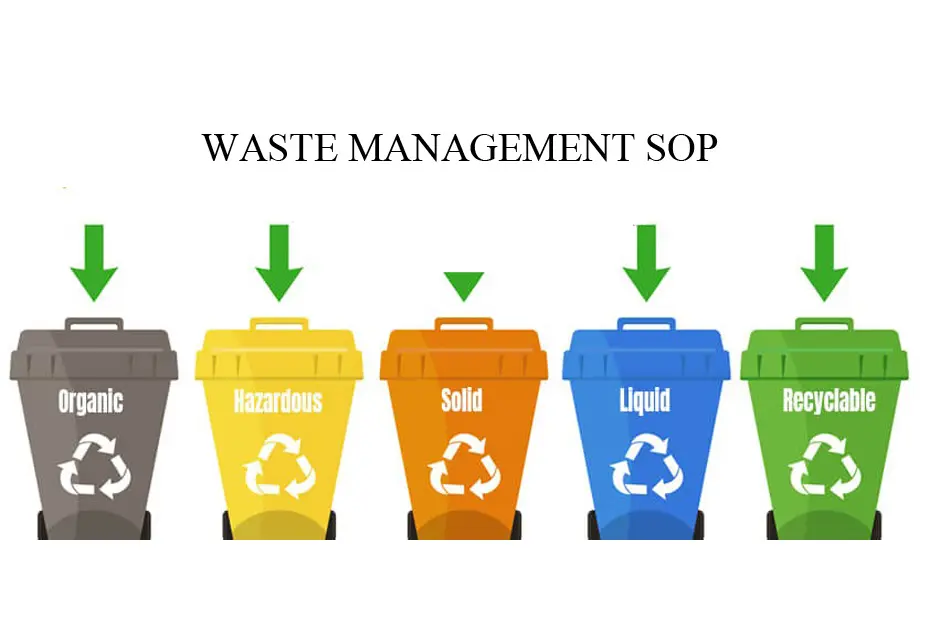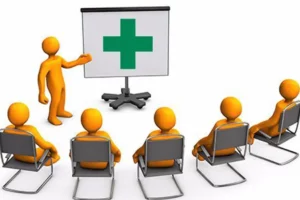1. Purpose
This procedure on Waste Management establishes guidelines and general rules to be followed for the proper management of waste at the Company Site.
The SOP aims to:
- Identify the types and quantities of waste that are generated due to the Site operation;
- Ensure proper management of all type of wastes generated at the Site;
- Promote awareness amongst site-personnel on managing waste;
- Identify and comply with all applicable regulatory requirements pertaining to waste management at the Site;
2.Scope
This procedure is applicable to: –
- All company employees;
- Contractors’ staff and workers, and,
This procedure is applicable within company premises.
3.Responsibility
- The Vice President, Operations, is ultimately responsible for the implementation of this procedure within the areas of his/ her administration (say, site/projects);
- Contractor’s Supervisor and Company EHS executive, Departmental Heads are responsible for the implementation of this procedure on a day-to-day basis; and
EHS executive, departmental heads is responsible for its review and modification.
4.Definitions
- Hazardous waste: Means any waste which by reason of any of its physical, chemical, reactive, toxic, flammable, explosive or corrosive characteristics causes danger or is likely to cause danger to health or environment.
- Disposal: Means deposit, treatment, recycling and recovery of any hazardous wastes.
- Storage: Means storing hazardous wastes for temporary period, at the end of which the hazardous wastes is treated and disposed off.
- Treatment: Means a method, technique or process, designed to change the physical, chemical or biological characteristics or composition of any hazardous waste so as to render such wastes harmless.
5.Legal & Other Requirements
- Hazardous and Other Wastes (Management & Transboundary Movement) Rules, 2016;
- E-Waste (Management) Rules, 2016;
- Bio- Medical Waste Management Rules, 2016;
6. Procedure
Reduce, Re-use and Recycle constitutes the basis for Waste Management at the Company Site. The company shall explore feasible options to reduce the quantity of waste (generated at the Site), re-use, recycle wastes and thereby facilitate appropriate management of all type of wastes at the Site. Figure 6.1 depicts the steps to be followed at the Company Site to ensure appropriate waste management.

Figure 6.1: Steps involved in Waste Management
These steps are further elaborated in subsequent Sections within this document.
6.1 Identify
The site shall identify the various categories of waste stream generated at the Site. Since there is no/very less requirement of water in the manufacturing process, therefore no/very less wastewater is generated from the processes it-selves. Waste water is generated from cleaning activities at the process areas. The table below lists the type of wastes that may be generated at the site.

Note: The site shall verify the type of wastes generated at the site from time to time and update the above list as necessary.
6.2 Develop Measures
The Company Site shall develop measures to manage the various types of wastes generated due to the Site operations. The Site shall explore possibilities of adhering to the philosophy of Reduce – Reuse and Recycle for waste management while developing the measures for managing various waste streams.
As a common practice for managing wastes the site shall ensure that various types of wastes are segregated at the source (i.e. point of generation) and stored at separate containers.
The Table below lists out the measures to be adopted for managing Hazardous Waste:

The Table below lists out the measures to be adopted for managing non-hazardous Waste:

6.3 Implement
- The Company site shall implement the measures identified in the previous step (i.e. Development of Measure) to ensure appropriate waste management at the site. The Company site shall provide adequate resources and facilities (such as separate bins for collection of storage of various types of waste, designated place for storing hazardous waste etc.). The site shall provide adequate trainings in order to raise awareness about waste management.
- The persons handling any form of hazardous waste shall be specifically trained to do so.
6.4 Monitor
The site shall periodically monitor (once in 3 months) the practice of waste management at the site and find out opportunity for improvement. The site shall Company monitor whether the applicable regulations regarding waste management are met. This include (but not limited to):
- Quantity of Hazardous waste generated at the site in a particular month (this amount should not be more than the permitted quantity);
- Length of the storage of hazardous waste at the site (this should not be more than 90 days after generated unless exempted by the Pollution control board);
- Quantity of wastewater generated from the site on a daily basis;
- Waste water criteria parameters;
- Documentation and record keeping system for waste management.
6.5 Action for Improvement
The site shall tale appropriate actions in order to close the gaps identified in the previous step (i.e. Monitoring). The gaps shall be documented and an action plan shall be prepared (against a timeline) for the closure of the gaps. The site shall Company identify best practices on Waste Management (appropriate for similar type of units) and consider implementing the same in order to continuously improve the practice of waste management at the site.
7. List of Relevant Guide Lines/ Documents
- Not Applicable
8. References
- Not Applicable
9. Related other Procedures
- SOP For Fire Prevention and Control;
- SOP for Permit to Work;
- EHS Risk Register.



